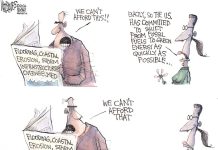
In more than 50 years in journalism, I’ve encountered my fair share of characters.
I’m not just talking about movers and shakers or people who make important contributions to the quality of life of their fellow man.
They’re important too, but the characters I best remember are those who fit under one of the dictionary definitions: “a person marked by notable or conspicuous traits.”
Unfortunately, it seems to me that these kind of “characters” are in shorter supply today than they were in my past.
I thought of that the other day after learning of the death of one of those characters: Jerry Castor.
Jerry was a man of many trades in his life. He was a radio announcer at a number of Indiana stations. At one point he drove racecars. And then there was his role as a promoter.
Jerry died Nov. 23 of congestive heart failure. It was a disease he had been battling for several years, one that eventually prevented him from participating in an annual event that he launched, nurtured, promoted and eventually handed over to someone else.
He called the event the Old Timers Reunion, and I still remember the day when he and fellow cofounder Dave Norris came into my office to pitch their idea.
It was 1998, and they wanted to resurrect memories of two long-gone racetracks in Columbus auto racing history: the old 25th Street Fairgrounds track, which was owned by legendary banker Francis Overstreet — a character in his own right — and the Columbus Speedway, which was little more than a depression just off State Road 7 south of Columbus, where fans watched the races from the surrounding hillsides.
They talked about memorable times at the two ovals — times which seem a far cry from the antiseptic auto racing world of today.
“Racing in those days was entirely different than what it is today,” Jerry recalled that day in my office. “It’s been cleaned up and everybody is a lot more professional. I can’t remember a time down at the Speedway when we didn’t have at least one fight in the infield or around the pits. Sometimes a fight would move from the grandstand across the tracks and into the infield.”
I listened to their stories of the past and in the most polite manner I could muster told them that the first reunion would likely be the last.
Just goes to show what I know. Earlier this year the 18th annual reunion was staged.
For most of its history, Jerry was the reunion. Dave Norris retired a few years after the series began and Jerry took over sole management.
It’s longevity can be traced in part to Jerry’s knowledge of his audience. As it turned out, there were quite a few people who remembered the old racetracks, and they in turn brought their children and grandchildren to the reunions to introduce them to old-time racing.
He invited people to bring their own memorabilia, even old racecars, and that became a staple of the reunions — groups of people standing around antique cars or tables laden with photos and trophies and recalling another era.
He went to great lengths to continue the early success, building upon decades of relationships to cajole car owners to loan historic vehicles for display.
One year the center of attention was the 1952 Cummins Engine Co. Number 28, which won the pole at the Indianapolis 500 with Freddie Agabashian behind the wheel.
Another year he came up with the novel idea of invi- ting owners of the cars that made up the 11th and last row of the 1950 “500.” One of those cars was Cummins’ “Green Hornet,” which had been on display at the Indianapolis Motor Speedway Museum. Another member of the last row had to be trucked from New Hampshire, which at the time was still digging out from a blizzard. It didn’t make it to Columbus, but it wasn’t for a lack of effort on Jerry’s part.
The “500” became a big part of the reunions. In the early years, he highlighted the careers of local racers like Pat O’Connor and Larrett “Crash” Crockett.
Since Jerry had spent a good part of his adult career promoting racing events, it was only natural that he looked upon the reunions as part of a revenue stream. It was more like a trickle.
“One year we decided to run the numbers on the profits, and it came out that we made 20 cents an hour,” he recalled years later.
I suspect he got a lot more from the old-timers who attended his reunion.
Harry McCawley is the former associate editor of The Republic. He can be reached at [email protected]. Send comments to [email protected].




